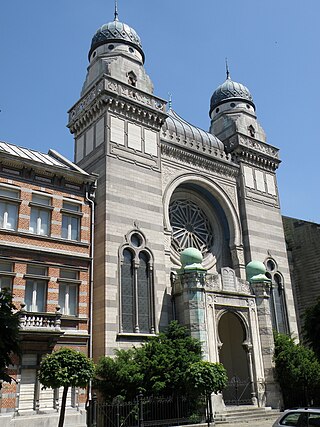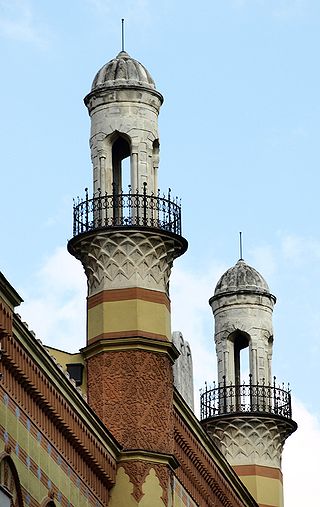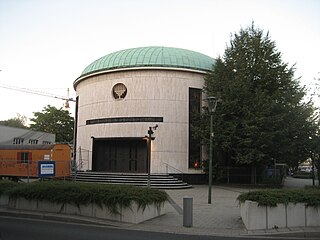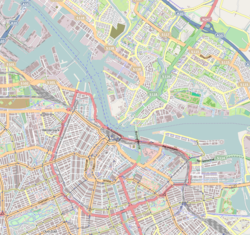
Amsterdam is the capital and most populated city of the Netherlands. It has a population of 921,402 within the city proper, 1,457,018 in the urban area and 2,480,394 in the metropolitan area. Located in the Dutch province of North Holland, Amsterdam is colloquially referred to as the "Venice of the North", for its large number of canals, now a UNESCO World Heritage Site.

Hagenow is a German town in the southwest of Mecklenburg-Western Pomerania, in the district of Ludwigslust-Parchim, 30 kilometers south of Schwerin. Its population is approximately 11,300 inhabitants (2013).

The history of the Jews in the Netherlands largely dates to the late 16th century and 17th century, when Sephardic Jews from Portugal and Spain began to settle in Amsterdam and a few other Dutch cities, because the Netherlands was an unusual center of religious tolerance. Since Portuguese Jews had not lived under rabbinic authority for decades, the first generation of those embracing their ancestral religion had to be formally instructed in Jewish belief and practice. This contrasts with Ashkenazi Jews from central Europe, who, although persecuted, lived in organized communities. Seventeenth-century Amsterdam was referred to as the "Dutch Jerusalem" for its importance as a center of Jewish life. In the mid 17th century, Ashkenazi Jews from central and eastern Europe migrated. Both groups migrated for reasons of religious liberty, to escape persecution, now able to live openly as Jews in separate organized, autonomous Jewish communities under rabbinic authority. They were also drawn by the economic opportunities in the Netherlands, a major hub in world trade.
The Nederlands-Israëlitisch Kerkgenootschap (NIK) is the umbrella organisation for most Ashkenazi Jewish communities in the Netherlands, and is Orthodox in nature, while to be described as traditional in outlook. The expression Orthodox, is for the Dutch situation at least, of a later date than the existence of the congregations that make up the NIK and the NIK itself. The Rabbi of the NIK is Rabbi Dr. Raphael Evers. In total, the NIK has some 20 rabbis actively working in 18 congregations throughout the country, serving some 5,000 Jews.

Beit Ha'Chidush, abbreviated as BHC is a Progressive Jewish congregation, located in Amsterdam, in the North Holland region of The Netherlands. The congregation was founded in 1995 by predominately expatriate Jews with secular and religious backgrounds who wanted to create a welcoming, inspiring and renewed Jewish congregation.

The Portuguese Synagogue, also known as the Esnoga, or Snoge, is an Orthodox Jewish congregation and synagogue, located at Mr. Visserplein 3 in Central Amsterdam, Amsterdam, in the North Holland region of The Netherlands. The synagogue was completed in 1675. Esnoga is the word for synagogue in Judaeo-Spanish, the traditional Judaeo-Spanish language of Sephardi Jews.

The Hollandse Synagoge, officially the Synagogue Shomré Hadas, and also known as the Bouwmeester Synagoge, is an Orthodox Jewish congregation and synagogue, located on Bouwmeestersstraat 7, in Antwerp, Belgium. Whilst the first Jews arrived in Antwerp in the 14th century, the congregation was not officially established until 1816. Descendants of Jews who came to Antwerp from the Netherlands in the early 19th century, built the synagogue in 1893 and it was the first large synagogue in Antwerp.

The History of the Jews in Amsterdam focuses on the historical center of the Dutch Jewish community, comprising both Portuguese Jews originally from both Spain and Portugal and Ashkenazi Jews, originally from central Europe. The two separate groups have had a continuing presence since the seventeenth century. Amsterdam has been called a Jerusalem of the West and the "Dutch Jerusalem". The Holocaust in the Netherlands devastated the Jewish community, with the Nazis murdering some 75% of the approximately 80,000 Jews at time present in Amsterdam, but the community has managed to rebuild a vibrant and living Jewish life for its approximately 15,000 present members.

The Rumbach Street Synagogue, also called the Status Quo Ante Synagogue, is a Neológ congregation and synagogue, located in Belváros, the inner city of the historical old town of Pest, in the eastern section of Budapest, Hungary. Since 2021, the building has also been used as a concert hall and Jewish museum.

The Worms Synagogue, also known as Rashi Shul, is a Jewish congregation and synagogue located in the northern part of the city center of Worms, in the Rhineland-Palatinate region of Germany.

The New Synagogue is an Orthodox Jewish synagogue, located at Zietenstraße 50, in Düsseldorf, in the Golzheim district of the state of North Rhine-Westphalia, Germany.

The Old Synagogue is a former Jewish congregation and synagogue, located in Erfurt, Thuringia, Germany.

Jan de Beijer, also given as Jan de Beyer, was a Dutch draughtsman and painter known for this drawings of towns and buildings in the present-day countries of the Netherlands, Belgium and Germany. In total, he produced some 1500 drawings, over 600 of which were reproduced as engravings by other artists.

The Karlsruhe Synagogue was a Jewish congregation and synagogue, located in Karlsruhe, in the state of Baden-Württemberg, Germany. Designed by Friedrich Weinbrenner in the Egyptian Revival style, the synagogue was completed in 1798 and demolished in 1871.

The Great Synagogue of Deventer is a former Jewish congregation and synagogue, located at Golstraat 23, in the city of Deventer, in the Overijssel region of The Netherlands. Designed by J. A. Mulock Houwer in a mix of the Renaissance Revival and Moorish Revival styles, the synagogue was completed in 1892.

Arnold Heertje was a Dutch economist and professor at the University of Amsterdam, writer and columnist. He became more generally known for his opposition to the Betuweroute.

The Aalten Synagogue is a Jewish congregation and synagogue, located at Stationsstraat 7, in the city of Aalten, in the Gelderland region of The Netherlands. The synagogue was completed in 1857, fell into disuse after World War II, was subsequently restored and reconsecrated in 1986.

The Görlitz Synagogue is a Jewish congregation and synagogue, located on Otto-Müller-Straße, in Görlitz, Germany. Built between 1909 and 1911 in the Art Nouveau style, the synagogue was the main place of worship for the city's Ashkenazi Jewish community. Despite an arson attack, the synagogue was one of the few synagogues in the area to survive Kristallnacht, sustaining only minor damage. The damage was lessened as firefighters ignored the Nazi German orders to let the synagogue burn. With the city's Jewish population depleted, the unused synagogue became a ruin in the following decades.

The Synagogue of Sulzbach is a former Jewish congregation and synagogue located in the town of Sulzbach-Rosenberg, in Bavaria, Germany. Built in 1822 on the site of two earlier synagogues, the building was abandoned in 1930, and was subsequently repurposed as a private residence form the 1950s, and returned to the Jewish community for use as a Jewish museum and community center since 2013.

Brazil—Netherlands relations refers to the bilateral relationship between Brazil and the Netherlands. Brazil has an embassy in The Hague and a consulate in Amsterdam, and the Netherlands is represented by an embassy in Brasília and consulates in Belém, Belo Horizonte, Curitiba, Fortaleza, Manaus, Natal, Porto Alegre, Recife, Salvador, Rio de Janeiro, Santos, São Paulo and Vila Velha.



















